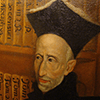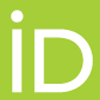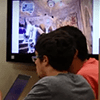This online, full-text collection of alternative magazines, journals, and newspapers from the second half of the 20th century is now available to members of the BC community. It will become fully open access in January 2019 thanks to contributions from Boston College and other CRL libraries.
Author: Eduards Tomas
From the University Librarian: The Way We Roll is Both Print and Digital
Tom Wall expresses his line of thought in maintaining library print resources and pleasant physical spaces, while developing the digital prowess of staff, collections, and services.
I started at BC eight years ago this spring. At that time, we had virtually no digital presence, and certainly no digital initiatives or programs. Now, as I consider my comments for the BC Libraries Spring Newsletter, I’m struck by the fact that almost all the articles revolve around digital programs and/or content in some way. Moreover, the delivery of the Newsletter is now entirely digital. Does this mean libraries are becoming only digital? Not at all.
In 1978, Frederick Lancaster wrote a provocative book entitled Toward Paperless Information Systems. Around that time, many people were predicting the demise of libraries, and one could argue that for much of the 1980’s that seemed like a real possibility. Then the idea of “Library as Place” began to germinate, perhaps partly inspired by the trend in bookstores offering open comfortable spaces for potential customers to read and relax in, and continuing as expectations of information service evolved, exemplified by the success of the Apple Store “Genius Bar”. I was fortunate to be at the vanguard of the transformation of library spaces throughout that time. Academic library spaces were becoming centers, places where students and faculty could meet and collaborate, access scholarly resources and research support, attend lectures and events, and learn from the early computing programs and resources available. In essence, the library became a destination for all things academic and a place to see and be seen.
These trends in transforming library spaces have continued throughout academic and public libraries, and we have been active in incrementally making similar changes here at Boston College. We have remained committed to print resources while introducing a variety of digital initiatives and services that integrate well with traditional services and allow us to expand the reach and impact of the work done on campus. In fact, folks should realize that much of what makes libraries successful goes on behind the scenes in the form of technical and technology services which in turn make items, both digital and print, easier to find and use from any location. At the same time, the physical library provides the tools, collaboration spaces and services for students and faculty to better discover, present and create using the vast amounts of content available through the BC Libraries. The positive reception of such changes at BC is evinced by the tremendous increase in the number of visitors to the library, up nearly 200% since 2009.
I’ve never been more excited about the role of the BC Libraries in providing services, spaces and content to our community and the global academic community. We have recruited staff from the best universities and research centers in the world, while developing strong, committed teams. We have become leaders in establishing undergraduate use of special collections; developed an increasingly global library in support of our unique content and mission; provided robust and collaborative digital scholarship opportunities; and maintained rock solid operations from a number of unsung heroes throughout the library. We continue our commitment to trying new things, exploring interesting ideas and taking strategic risks. Most of all, we greatly value input from all of you. Throughout the spring, we will be reaching out to the community to gather your ideas and perceptions of the Library and our services. If you have comments or suggestions in the meantime, we encourage you to reach out to the library staff directly or through our feedback form. We take your feedback seriously as we strive to live up to the BC motto of “Ever to Excel”.
Making the Modern Modern: Digitizing Francisco Suárez, SJ
Burns Library and the Digital Library Program have teamed up to digitize works by Spanish Jesuit philosopher and theologian Francisco Suárez.
How can you properly study an author whose collected works have not been reprinted in nearly a century and a half?
Digitize them.
What if they comprise 28 oversize volumes?
Digitize them. All of them. The two volumes of indexes included.
In 2011, the Boston College Libraries Digital Library Programs did just that for the “opera omnia” of the Spanish Jesuit philosopher and theologian Francisco Suárez (1548–1617), which were last published in Paris between 1856 and 1878.
When Robert Maryks, an associate director of the Institute for Advanced Jesuit Studies and editor-in-chief of the Journal of Jesuit Studies, arrived at Boston College in 2013, he took note of this achievement and encouraged the Libraries to also digitize earlier printings of Suárez’s works so that their editorial history could be critically examined. With the 400th anniversary of Suárez’s death approaching in 2017, and an accompanying resurgence of interest in a thinker who pivoted medieval Scholasticism toward modern concepts of the individual and society, Maryks contended that Boston College could contribute much to contemporary scholars’ investigations of Suárez by making the older editions of his works more accessible, digitally.

Burns Library holds the most extensive collection of Jesuit philosophical and theological works in North America, so it could provide a ready supply of rare, early copies of Suárez’s works for the project.
A prospective list of 49 titles in 121 volumes was generated by Head of Digital Library Programs Betsy Post in May 2014. Maryks reviewed and approved the list, and the scanning soon began. About half of the volumes, the sturdier ones, were sent to Internet Archive scanning team at Boston Public Library. Over the years, the Libraries have contracted with the team to scan thousands of books.
Some of the Suárez volumes were too bulky or too fragile, and so were scanned by Libraries’ staff on the Atiz scanning station in Burns Library. The Atiz has a pair of Canon EOS 5D Mark II cameras that capture double-page openings at 375 pixels per inch. Digital Content Specialist Cheryl Ostrowski logged 384 hours capturing a total of 45,682 pages from 63 volumes—an impressive rate of 119 pages per hour. Imaging Assistant Naomi Rubin managed a group of nine students who devoted another 802 hours to “post-processing”—straightening and cropping images to correct alignment issues caused by the special propping needed to gently open the antique bindings for scanning.
Several other Libraries’ staff contributed their time and expertise to the project as well, in particular Digital Production Manager Bill Donovan and his successor Chris Mayo, Conservator Barbara Hebard, and Rare Book Cataloger David Richtmyer.
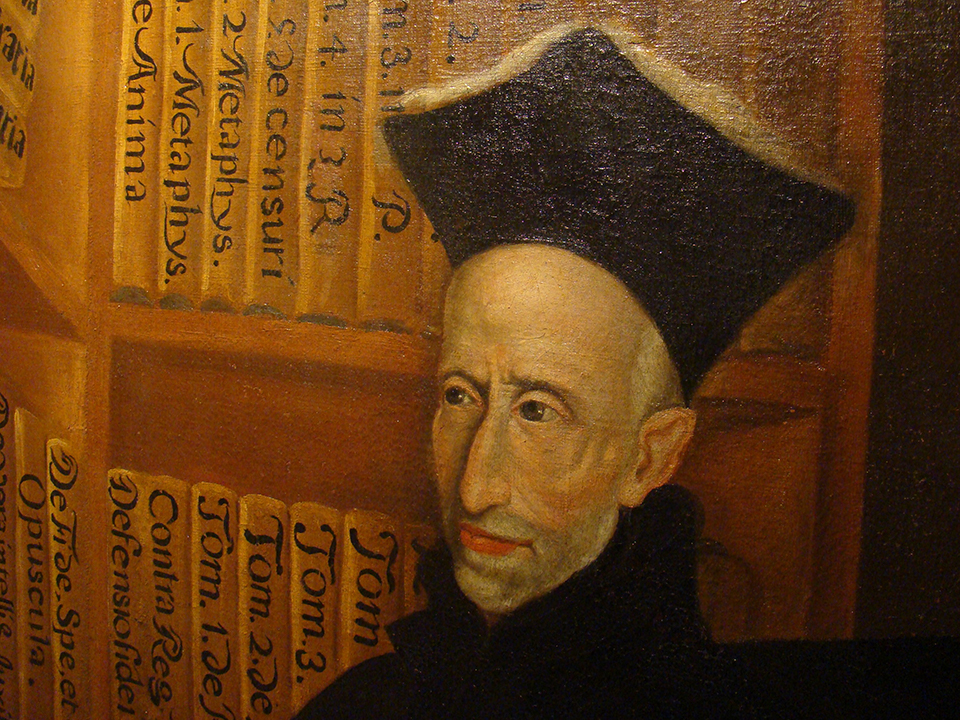
By August 2016, the last of the volumes had been scanned. The final tally: 44 titles in 119 volumes, all of which can be freely viewed and downloaded via the Internet Archive website as well as the HathiTrust digital library. Records in the Libraries’ own catalog contain links to the online versions as well as call numbers for the original copies, which may be consulted in the Burns Library Reading Room.
Francisco Suárez Collection on the Internet Archive
Quick stats:
- 44 titles in 119 volumes published between 1599 and 1878
- 24,745 page views as of January 1, 2017
Already, Internet Archive statistics suggest a story of scholarly use. Collectively, the 28 volumes comprising the Parisian Opera omnia edition have received more than 18,000 pages views since they went online in 2011. The more recently added volumes—all of which represent earlier editions of treatises included in the Opera omnia—have received another 6,000 page views. This last figure could indicate that some researchers are comparing the transmission of texts through successive printings.
Suárez is not an easy thinker to penetrate, yet his influence has been wide-ranging and far-reaching, leaving its marks on philosophers more commonly associated with modern thought such as Descartes and Leibniz, Locke and Heidegger. For historians of Jesuit intellectual culture like Maryks, Suárez embodies elements of “Jesuit distinctiveness,” which make him all the more interesting to scholars today whose inherently interdisciplinary approaches bring sociological concerns to textual analysis. Providing digital access to a comprehensive corpus of Suárez’s works in their various editions can render such investigations more practical and more fruitful.
To commemorate the 400th anniversary of Suárez’s death and bring renewed attention to his legacy, the Institute for Advanced Jesuit Studies is co-organizing a symposium on Suárez and early modern Jesuit philosophy in Seville, Spain, in 2018.
BC ORCID is Coming
The Libraries and ITS are working together to bring enhanced ORCID functionality to BC researchers.
You will soon have a new way to distinguish yourself and your work from all others.
Boston College has become a member of the ORCID (Open Researcher & Contributor ID) organization. When you register for an ORCID (a process that takes about one minute), you receive a unique researcher identifier. At Boston College, the Provost’s Office, Information Technology Services and the Libraries are joining forces to provide a new interface for faculty, researchers and students to register for an ID and associate it with their Boston College identity.
One of the primary problems ORCID solves is name ambiguity. Research queries turn up articles by authors of the same name, across a wide variety of disciplines. This issue plagues researchers and university tenure committees alike and the problem increases as interdisciplinary work becomes more common. The ORCID ID is a unique, persistent number that identifies and travels with the researcher through changes in institution. It is not affected by name changes, cultural differences in name order, inconsistent use of initials, or use of different alphabets.
Importing publication data using other system IDs (such as Researcher ID) and databases (such as Scopus) is easy and ORCID tracks 37 types of works – including not just text but datasets, performances and artworks, making it a system that can be used by all disciplines.
This ID will:
- Serve as a unique, persistent identifier for you throughout your career across institutions and disciplines
- Distinguish your work from others’ in the field and give it greater visibility
- Allow you to create a profile that connects all of your scholarly output with your ID, including non-traditional works
- Streamline submissions to publishers and grant funders, who increasingly integrate ORCIDs into their processes and send data to your profile
- Automate annual reporting in systems that offer ORCID integration, such as Data 180
- Give you control over what is made public, private, or available only to trusted parties
The benefits for Boston College include accurate, up-to-date information on scholarly output and the ability to follow the careers of our scholars and graduates.
We hope to roll out this new interface later this Spring. In the coming months, the Boston College Libraries will offer opportunities for you to learn more about ORCID. You will be able to register for an ORCID ID linked to your Boston College credentials, or to link an ORCID you already have.
In the interim, please read more on the Libraries’ ORCID webpage.
Undergraduate Theses in eScholarship@BC: a Part of Boston College’s Institutional Record
Learn about the preservation of faculty-approved undergraduate theses in Boston College’s institutional record through archiving in eScholarship@BC, the Libraries’ digital repository.
 The Boston College Libraries make it possible for senior thesis students to archive their faculty-approved projects in eScholarship@BC, the Libraries’ digital repository. Archiving the work in the repository affirms that Boston College takes seriously the endeavors of seniors as aspiring scholars. The archive can be helpful to academic departments in documenting the accomplishments of their students, and in providing references and examples to future thesis writers. Faculty encouragement of senior thesis writers to place their work in the repository should add incentive for students to take their projects seriously and to adhere to the standards of proper scholarship. Students who undertake thesis projects, knowing that their work will be available to the wider scholarly community, could be impelled to higher levels of academic achievement. Additionally, students who give access to their theses beyond Boston College can include the permanent web address in their résumés for potential employers. Academic departments and their students can thus benefit from having theses archived in eScholarship@BC.
The Boston College Libraries make it possible for senior thesis students to archive their faculty-approved projects in eScholarship@BC, the Libraries’ digital repository. Archiving the work in the repository affirms that Boston College takes seriously the endeavors of seniors as aspiring scholars. The archive can be helpful to academic departments in documenting the accomplishments of their students, and in providing references and examples to future thesis writers. Faculty encouragement of senior thesis writers to place their work in the repository should add incentive for students to take their projects seriously and to adhere to the standards of proper scholarship. Students who undertake thesis projects, knowing that their work will be available to the wider scholarly community, could be impelled to higher levels of academic achievement. Additionally, students who give access to their theses beyond Boston College can include the permanent web address in their résumés for potential employers. Academic departments and their students can thus benefit from having theses archived in eScholarship@BC.
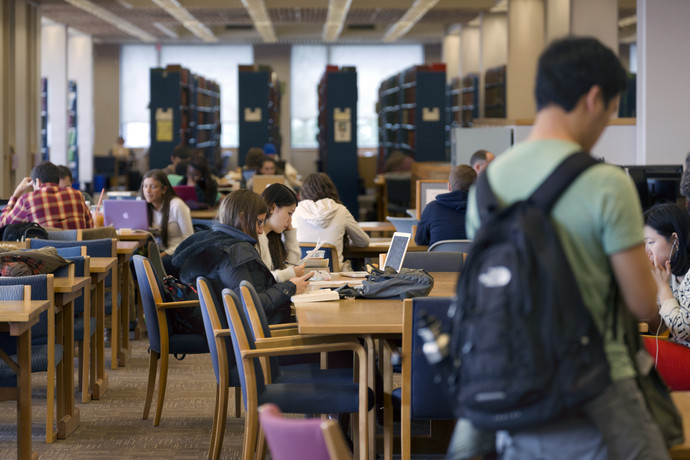
The eScholarship@BC program makes possible the preservation of the thesis work of undergraduates as part of the University’s institutional record. Archived theses are accessible either openly via the internet, or on Boston College campus premises only. Students, with guidance from their faculty advisors, can elect the most suitable type of access on the thesis deposit form.
The Libraries support thesis students who take advantage of the eScholarship@BC program in many ways, including research assistance provided by subject librarians during the writing phase, and procedural aid when the time comes for actual submission into the repository.
Guidelines and instructions for submitting a thesis to the repository can be found on the Undergraduate Theses Submission Guidelines page.
Examples of undergraduate theses archived in eScholarship@BC at present can be seen here .
Questions regarding the undergraduate thesis deposit program may be directed to Lopa Williams at lopa.williams@bc.edu .
Libraries Introduce New Digital Scholarship Group
O’Neill Library’s Digital Scholarship Group offers expertise in emerging methodologies and tools.
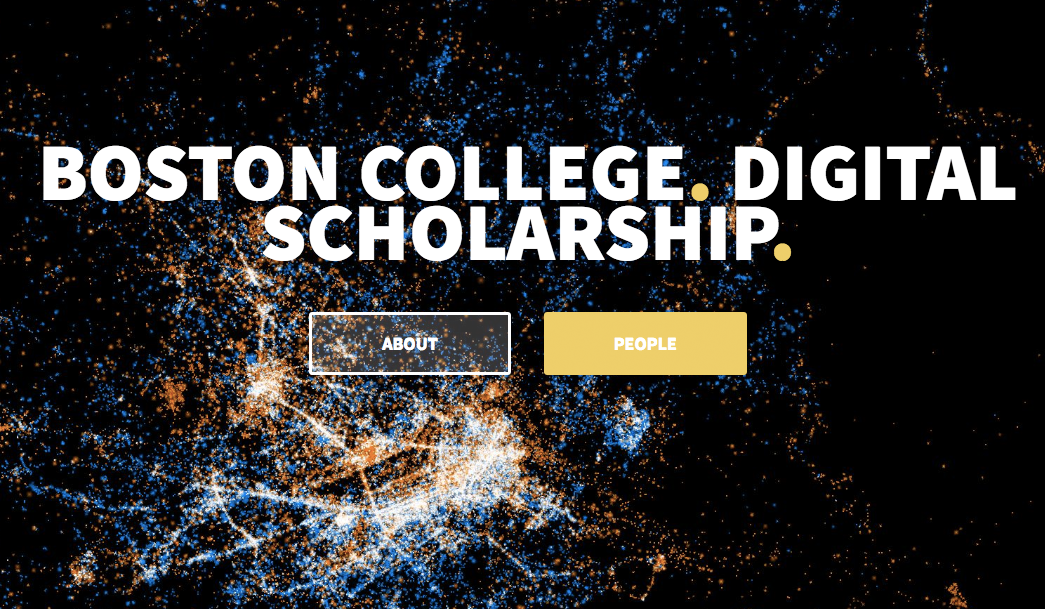
The Digital Scholarship Group at O’Neill Library is excited to announce the recent addition of three new members. Sarah Melton, the Head of Digital Scholarship, joins BC from Emory University’s Center for Digital Scholarship in Atlanta, Georgia. Stephen Sturgeon is the new Senior Digital Scholarship Librarian and English Bibliographer and comes to BC from the University of Iowa Libraries. Joining the group from Wake Forest University Libraries is Chelcie Rowell, BC’s new Digital Scholarship Librarian and History Bibliographer .
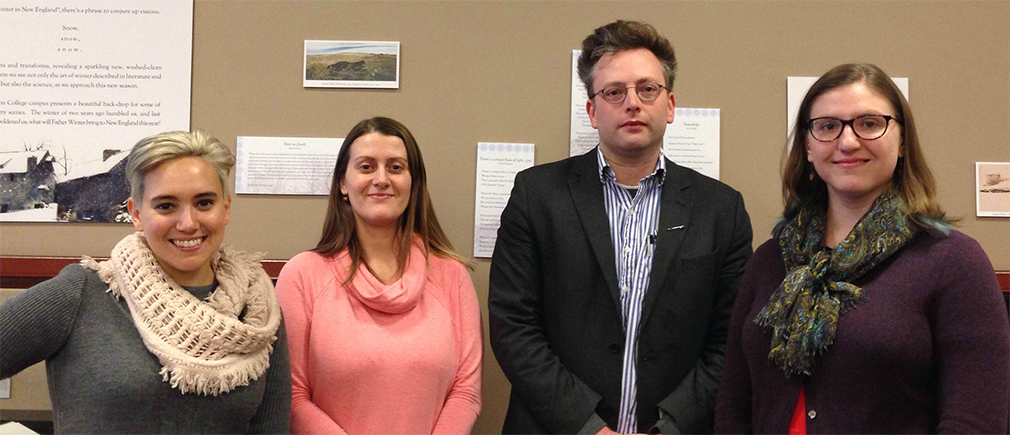
The Digital Scholarship Group helps faculty and students reimagine their research and teaching to incorporate emerging technologies and innovative techniques. Faculty can partner with the team to build web exhibits, maps, and other digital projects. In addition to one-on-one consultations, the Digital Scholarship Group offers workshops and training opportunities throughout the semester, such as the Coffee & Code series that introduces participants to technologies and methodologies.
This semester, the group will offer workshops on making maps online, building digital exhibits, managing your research data, and more. All Coffee & Code sessions take place in the Digital Studio in O’Neill Library and are free and open to the public.
- The February Coffee & Code event will teach participants how to use data to make maps online. For participants interested in visualizing historical data for humanities or social science projects or classroom use, the workshop will introduce the basics of using geographic data to create a map with Carto, a web-based mapping and analysis tool. The workshop will be held on February 9 from 11-12:30 pm.
- If you’ve ever wanted to learn how to create digital exhibits, Anna Kijas will lead a workshop on Omeka in March. Omeka is a free software that allows users to upload, tag, and arrange items into collections and exhibits.
- April’s Coffee & Code will introduce participants to textual analysis using the free citation management software Zotero and the visualization plugin Paper Machines. By the end of the session, you’ll be able to recognize whether or not the text of a PDF can be read by computers, create visualizations of large collections of items in your Zotero library using Paper Machines, and frame a research question that visualizations created using Paper Machines could help to answer.
For more information about these and future workshops, please visit the Digital Scholarship Events page.
The Digital Scholarship Group looks forward to getting to know you! Subscribe to the digital scholarship newsletter to learn more about our projects, activities, and events.
Core Skills Tutorials
Eight new tutorial library core skills videos were produced in Summer 2016, and are now available via the library website and via Canvas Commons, along with corresponding quizzes.
Thanks to a recent Academic Technology Innovation Grant (ATIG) and invaluable assistance from Brian Zimmerman of the First-year Writing Program, the BC Libraries have created and launched a series of Library Core Skills videos that introduce students to the basics of research and citation management, along with short quizzes to test knowledge and skills. All eight videos, housed in YouTube, are available both through the library website and through Canvas Commons; any video or quiz can be added to a Canvas course with just a few clicks.

Teaching librarians developed the tutorials in response to a growing recognition that they weren’t consistently able to reach all students with short courses in core library skills. The majority of students receive at least one library session as part of their First-year Writing Seminars, but many students are exempted from FWS because of advanced placement scores or transfer credits. Other students also may wish to review skills on their own. Tutorials include an introduction to the libraries, using the catalog and databases, advanced searching techniques, focusing research, citation management, evaluating internet resources, and identifying primary and secondary sources.
Production of the “Introduction to BC Libraries” video actually predates the rest of the project by a year; it began in Spring 2015, when a talented group of students and an ITS Help intern collaborated on the concept, and then storyboarded and shot the project, with oversight and scripting assistance from librarians. Creating the bulk of instructional videos began during the 2015-16 academic year with careful planning of learning outcomes, taking into account library learning goals, FWS goals, prerequisite skills for learning advanced research for upper-level courses, and information literacy frameworks developed by the Association of College & Research Libraries (ACRL).
Beginning in summer 2016, the production team developed script ideas in collaboration with Brian Zimmerman, a senior instructor for FWS. Brian then drafted scripts for each of the videos, which were in turn reviewed by the entire production team. Each script went through the same intensive iterative drafting process. Brian then created video by capturing screen content with Camtasia and other screen capture tools, and by creating and altering images in Powerpoint and Photoshop. For much of the summer, he was the heaviest user of Digital Studio equipment, staff, and resources. Steve Runge, meanwhile, recruited student employees in the libraries and other departments to create voice narration with the new sound room in the Digital Studio.
Though the whole team participated in the drafting process, each video was directed by a librarian who took responsibility for making sure each video focused on the learning goals; Brian patiently returned to redraft many script sections as the director and team refined the focus, meeting production targets and finishing 7 videos in just over two months.
To illustrate the ACRL Framework “Research as Inquiry,” which emphasizes the iterative nature of research, the “Focus Your Research” video describes the “research cycle,” in which a student moves back and forth between their search terms, research tools (like databases) and their research question. In a less direct way, the “Finding Books and Other Items in the Catalog” video walks a novice researcher through increasingly complex search techniques that reinforce that iterative process.
You can direct your students to the videos a variety of ways, all of which are described in a library guide about Adding Library Tutorials to Your Course. You could provide a link to the full page of videos for more self-directed students, or link to individual YouTube videos for content you would like to emphasize in an email or syllabus. To express a little more strongly that a video is course content, you could also embed the videos directly in your Canvas course, either by using the YouTube tool in Canvas or by importing from Canvas Commons. Finally, if you want students to self-assess their understanding of the videos you embed, you could import the corresponding quizzes from Canvas Commons. If you are interested in this adding this content to your Canvas course, you can find instructions on the BC Library website or contact your subject specialist for more information.
New Web of Science Resources
The Web of Science database platform has added a wide range of new component databases, including Book Citation Index to find book citation data from 2005 on, Data Citation Index to find published datasets, Derwent Innovations Index, Zoological Record, various international search options and more. These resources can be found by clicking the orange check-box next to Web of Science Core Collection (the default) to open the drop-down menu showing component databases. Check with your Subject Librarian to learn more about any of these new additions to the Web of Science.
Access World News
Access World News is a collection of local, regional, and international news sources. Additionally it provides access to many sources of foreign news in translation.
BioCyc Database Collection
This previously open collection of databases is now being offered as a community supported, nonprofit resource. Drawing from over 60,000 publications, BioCyc provides data for metabolic pathways and genomes for a variety of organisms, with tools for analyzing the data. There is particularly rich and professionally-curated data for intensively researched species like Saccharomyces cerevisiae, Mycobacterium tuberculosis and Clostridium difficile. For more information, contact Sally Wyman, Chemistry and Physics Librarian, or Enid Karr, Biology and Earth & Environmental Sciences Librarian.

